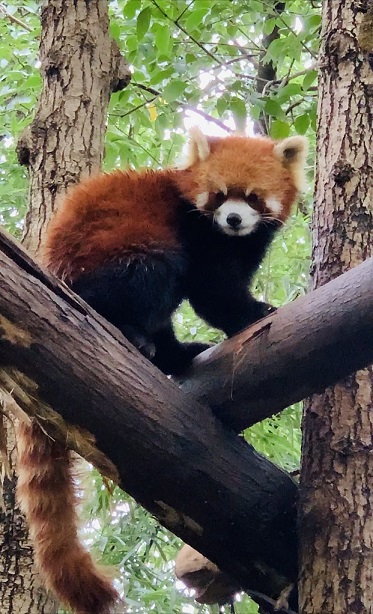The red panda (Ailurus fulgens), also known as the lesser panda or firefox, is a small, arboreal mammal native to the temperate forests of the Himalayas and southwestern China. Despite its name, the red panda is not closely related to the giant panda; instead, it belongs to its own unique family, Ailuridae. With its striking reddish-brown fur, bushy tail, and adorable face, the red panda is a beloved symbol of wildlife conservation.
Physical Characteristics

Size: Red pandas are about the size of a domestic cat, measuring 50 to 64 cm (20 to 25 inches) in body length, with a tail adding an additional 28 to 59 cm (11 to 23 inches).
Weight: They typically weigh between 3 to 6 kg (6.6 to 13.2 lbs).
Fur: Their thick, soft fur is reddish-brown on the upper parts and black on the underside, providing excellent camouflage in their forest habitat.
Tail: Their long, bushy tail helps them maintain balance while climbing and also serves as a warm cover during cold weather.
Habitat and Distribution
Red pandas inhabit temperate forests with dense bamboo understories, at elevations ranging from 2,200 to 4,800 meters (7,200 to 15,700 feet). They are found in regions of Nepal, India, Bhutan, Myanmar, and China. Unfortunately, their habitat is shrinking due to deforestation and human encroachment, making them a vulnerable species.
Diet
Red pandas are primarily herbivorous, with bamboo making up the majority of their diet. However, they are technically omnivores and also consume fruits, berries, acorns, eggs, and small animals like insects and birds.
Behavior
- Solitary Nature: Red pandas are mostly solitary animals, except during the breeding season.
- Nocturnal and Crepuscular: They are most active during dawn and dusk, spending their days resting in trees.
- Climbing Skills: Their sharp claws and flexible ankles make them excellent climbers, and they spend much of their time in trees.
Conservation Status
The red panda is classified as Endangered by the International Union for Conservation of Nature (IUCN). Major threats include habitat loss, poaching, and climate change. Conservation efforts focus on habitat protection, anti-poaching measures, and breeding programs in zoos worldwide.
Fun Facts
- Red pandas are skilled escape artists and can easily climb trees to evade predators.
- They communicate through a variety of sounds, including whistles, twitters, and huff-quacks.
- Their scientific name, Ailurus fulgens, means “shining cat,” reflecting their cat-like appearance and glossy fur.
The red panda is a unique and enchanting creature that plays a vital role in its ecosystem. Protecting this species and its habitat is essential for maintaining biodiversity and the health of our planet.
